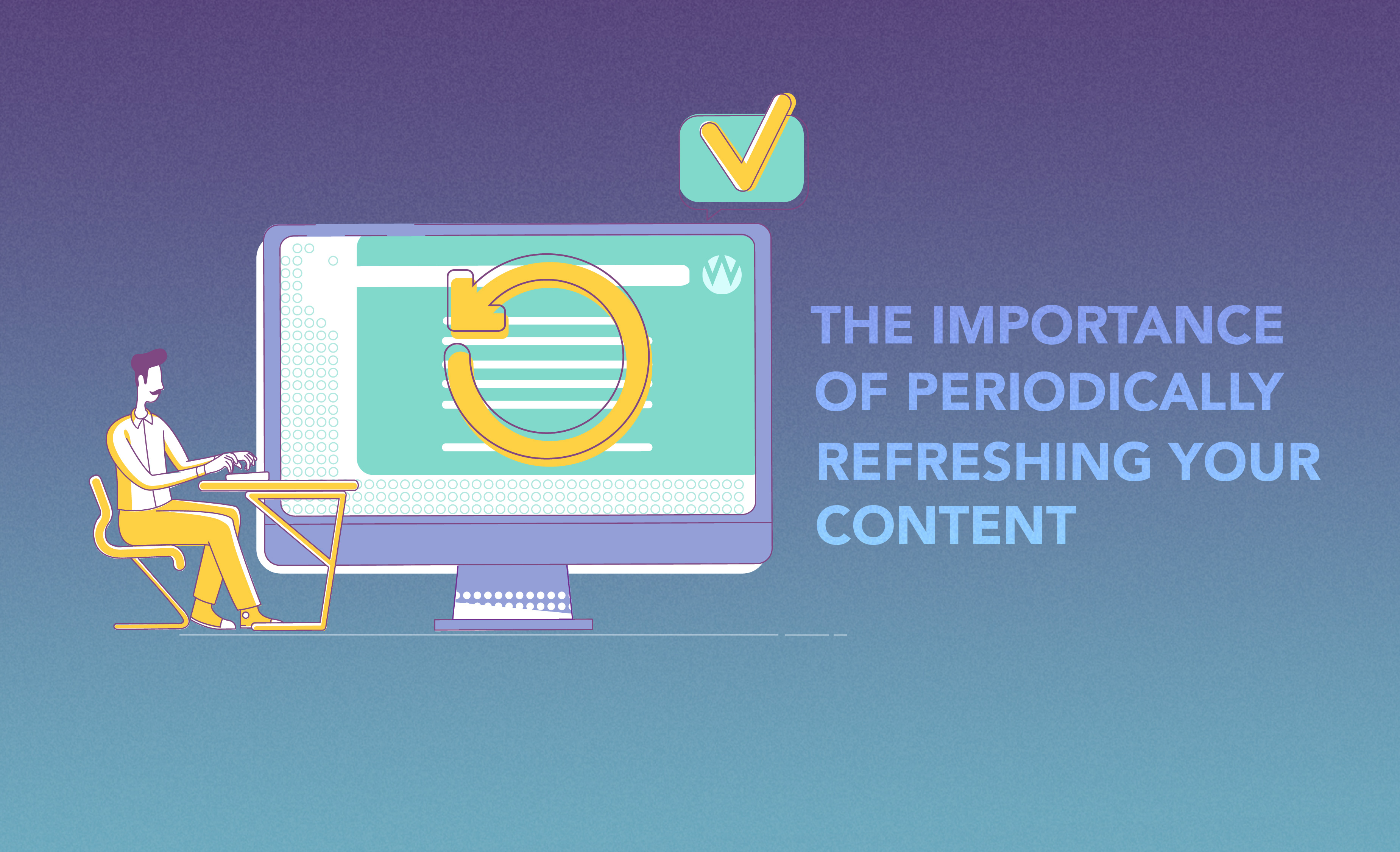By Sian O'Carroll on 10 Mar 2021

You’re spending hours creating stellar content for your business, watching with pride as it goes live and the views start rolling in. Then over time, you see them declining until (to your horror) your blog post is bringing in little to no traffic.
All good things must come to an end, you tell yourself. But do they really?
We don’t take no for an answer here at Wolfgang, and we love seeing the potential in everything. So here’s why our content marketing team loves refreshing older content, and why you should be doing it too.
Why refresh old blog posts instead of creating new ones?
Pumping your blog full of fresh new content might seem like an obvious way to boost traffic, conversions and brand awareness, but the harsh truth is it takes a lot of time and effort.
Giving your worn-out existing content a new lease of life is a quick win, and can bring in remarkable results if done right.
Why does content start losing traffic over time?
1. Google prefers fresh content
We might love our older content just as much as the new stuff (no favourite children here!) but we can’t say the same for Google.
The Big G much prefers fresh content, and will prioritise it over older articles; after all, Google wants to give search users the most up-to-date, relevant information they can. Luckily, they don’t actually care if the content is a brand spanking new article, or older content that’s been refreshed and expanded.
2. More competition over time
If you were first to cover a hot new topic, well done.
Now cover it again, because all your competitors have had weeks or months to catch up with you, and add in all the extra information on the topic that wasn’t around when you wrote about it.
Content marketing today moves at a phenomenal pace, so regularly checking that your old content is still relevant is worth your while, not only to make sure you’re staying ahead of your rivals, it’ll help build your brand’s E.A.T. too.
3. Algorithms and SERP updates
Google loves an update, and search algorithms regularly change. Your once tried-and-tested SEO content marketing strategy might one day be redundant, so it’s worth keeping on top of updates and changing up your existing content to work with them.
What can you gain?
Why is updating old content absolutely worth your while, you ask?
- It grows traffic
- It grows revenue
- It keeps content relevant
- It gets you SERP and Google Discover features
Let’s take a look at one of our clients.
In Q3 2019, we began optimising existing posts on the Littlewoods Ireland blog. Following a full content audit, we identified posts with great SEO potential; they were expanded to target new keywords, cover the topics more fully and better integrated with our overall SEO strategy.
The result? More traffic, more conversions and more revenue: :
- Revenue from the blog is up 55.88% YoY
- Assisted conversions are up 25.05% YoY
- ROI from the blog has increased 16% YoY (5.1:1)
- Organic sessions on the blog are also up 16.12% YoY
These results can largely be attributed to our optimised posts, which have remained top-performers since their updates.
So, what went right?
1. Optimised posts are consistently bringing in the most traffic and ranking in top positions for their keywords
We looked at a sample period of 3 months after posts were optimised, and compared it to the average organic traffic they brought in before optimisation, and the results are conclusive

The minimum amount that organic traffic grew by was 200%.
It comes as no surprise, then, that in general, optimised posts improved their ranking on Google. Most of them are ranking in top spots for their keywords:
They're also being picked up for various SERP features, including featured snippets, image packs and People Also Ask.
2. Optimising posts increases their individual value
Optimisation is also leading to a growth in revenue from those posts. Looking at two more examples from our top-performers, we can see increases of up to 139% in direct revenue.
In fact, if you time your optimisation well enough, you can rake in the revenue.

In Q4, we identified a Christmas-themed post that had a small amount of increased interest, but wasn’t performing too well overall. We optimised it, expanding the content and adding in relevant keywords and images.
Post-optimisation, the revenue brought in from this blog post increased by a whopping 1723.10% when compared with the same period the previous year.
It also shot into the top 10 posts, with 2082.61% growth in organic traffic year on year in December alone. It's also now ranking for 19 keywords. Win-win.
3. Many of these posts featured on Google Discover
Why is this important?
Because Google Discover brings in a huge amount of clicks.
Google Discover is a relatively new platform, and one we’re continuously learning more about, but we do know a few key points when it comes to winning spots on it. It not only drives an impressive amount of clicks, it brings in high-quality conversion-ready traffic, too, as it provides tailored blog suggestions based on individual user’s interests.
We know content needs to be timely, optimised and user-friendly, as well as fresh; all key aspects of optimising older content.
So, how do you go about refreshing your content?
If you can write an SEO blog post, you can optimise one.
It’s really all about going back on your old work to see what could be better, what’s no longer relevant and what you could expand on.
Your first step is finding content worth optimising.
If you don’t have a huge amount of content, you’ll probably easily be able to spot posts that are decreasing in sessions or revenue by taking a quick look at your analytics.
If you’ve got plenty of content already, a full content audit is your best bet to pick out articles that need an update. Don’t worry, we’ll show you how to content audit, too.
How do you spot content worth optimising?
- Look for posts that have had some amount of organic traffic in their history; this shows us that there’s search demand around the topic and your customers are interested.
- Look for posts that have had a drop in traffic over 3 months; usually, these posts are on a steady decline, but that can easily be reversed.
- Look for posts with small to medium amounts of organic traffic that could be improved and expanded.
- Look for posts that are experiencing small increases in traffic that could be improved; this could even be seasonal interest, and if you time your optimisation right you could maximise on that extra search volume.
Once you’ve picked out your posts, there are a few key things you should do.
1. Refresh old links
Go through any links in your post and make sure they are up to date and targeting the right pages. Check and update backlinks too.
2. Add in new relevant keywords
Check the keywords you’ve used in the original copy against your current SEO strategy. Do they align?
A quick search on SEMrush or Ahrefs can give you new, relevant long tail keywords to add to your expanded content and help capture even more organic traffic per month.
You’ll also want to double check that your meta description and title are in order and targeting your focus keyword.
3. Restructure
All good content marketers are familiar with SERP features and how to win them. Google likes easily readable, scannable content broken up into informative chunks that answer specific search queries.
Make sure your content is structured around answering search queries, avoid long paragraphs, and break your text up with plenty of bullet lists, tables and step-by-steps giving your readers the information they’re searching for.
And whatever you do, don’t forget images!
4. Expand
In theory, Google will always rank the best content first. Content that gives users the best information on a topic is more likely to rank above other posts, so it’s more than likely worth expanding your content to cover the subject better.
We love using Thruuu to find out what our competitors are saying about a topic, how many words they’re writing and what we can add in that they don’t have.
5. Promote it again!
Make sure to create a buzz around your newly updated content by sharing it on social and through outreach.
If it’s well-timed, it could get picked up for some lovely backlinks!
Content optimisation 101:
- Update the publish date on your blog post so Google can easily recognise it as new content.
- Don’t change the URL! You don’t want to lose any historical rankings or traffic.
- Keep content evergreen; it’ll bring the most long term value. One of the benefits of content marketing is that it drives long term traffic and revenue once you write about topics that remain relevant over time.
- Get rid of any irrelevant posts that you’re not updating; make sure to use a 301 redirect so you don’t lose any SEO value.
The Wolfgang Takeaway
Optimising your existing content might not seem as glamorous as creating shiny new blog posts, but the results simply don’t lie.
Starting from an already established base of organic traffic and ranking keywords, updating an existing post can quickly bring in huge volumes of extra organic traffic and conversions; considering it takes new posts 3 months on average to start ranking, this is certainly a quick win not to be missed.
Compared to planning out new topics, completing research from scratch and starting from a word count of zero, refreshing old content is looking extremely tempting. Right?
‘Out with the old, in with the new’ has never seemed so irrelevant.


.png)
.png)







_2025.png)

